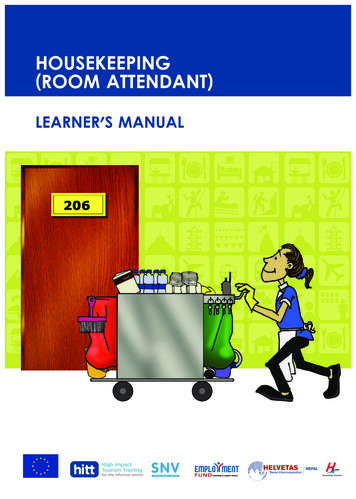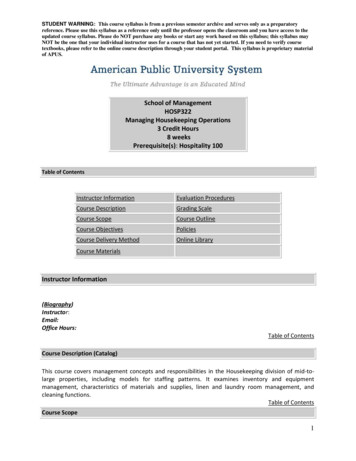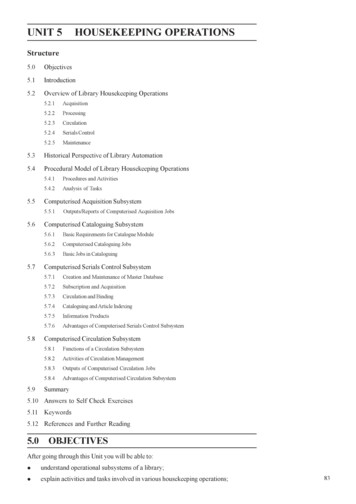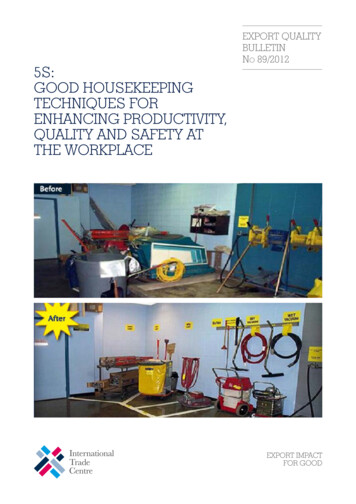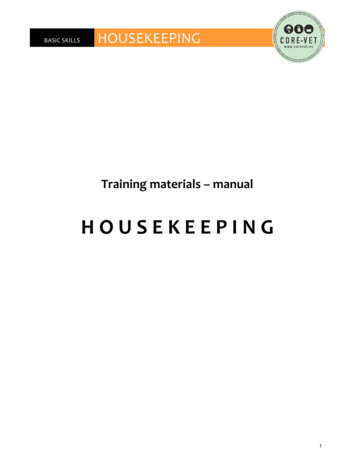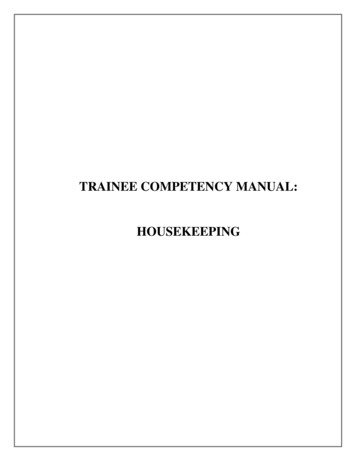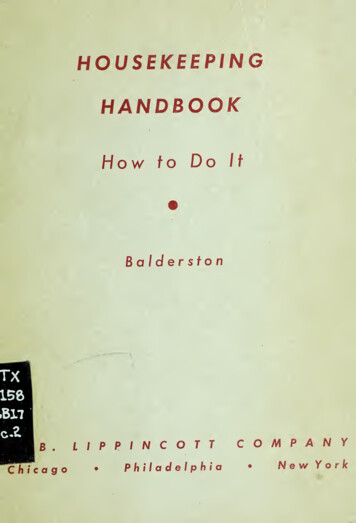
Transcription
HOUSEKEEPINGHANDBOOK\How to Do ItBalderstonLIPPINCOTT PhiladelphiaCOMPANY New York
(3x amisiarawiwis
Digitized by the Internet Archivein 2019 with funding fromUniversity of Alberta andOObald
HOW TO DO ITByLYDIA RAY BALDERSTONFormerly InstructorTeachers College, Columbia UniversityNew York CityAuthor of HOUSEWIFERYJ. B. LIPPINCOTT COMPANYChicagoPhiladelphiaNew York
Copyright, 1944, 1935, by J. B. Lippincott Company[4.749]To My FriendE. H. G.Lj.:,*t* V&&Printed in the United States of America
FOREWORDThis very useful and attractive Housekeeping Handbook is a much neededpiece of teaching material for the many classes in home-making and householdservice which are being conducted throughout the country.For many years, as a State Supervisor of Home Economics, the writer has feltthat teachers and students are greatly handicapped in not having before themdefinite information and rules as to how to do a definite piece of work in thehome. Since there is usually one best way in which to do every piece of work,why not have the rule for that way available in compact form before the teacherand the student, the home-maker and the houseworker?In visiting classes, the writer has often heard the teacher say, “Dust the living dining room,” “Clean the floor,” “Clean the kitchen sink,” etc., and the studentimmediately goes to work, without discussion or directions or thought as to theefficient way to proceed. This leads to bad practices and tiresome drudgery.This little Handbook will make it easy for both student and teacher. They willfind here, clearly stated, the correct information and the efficient method. Theirlearning will be positive, their results good, and the task more joyfully accom plished.Home-making has long been considered a science, and a few have seen that itcan be a fine art. The writer believes that home-making now needs more art tocreate a soul or spiritual values within it, for we are dealing with human beings asthey daily live together. Harmony and order, together with beauty and cleanli ness, establish surroundings that make for good living and for appreciation ofwholesome family and home life. This book provides the background for bringingmore of this desirable kind of living into the home.The writer would like to recommend it for use in home-making classes, for bothboys and girls, in junior and senior high schools. General science classes wouldalso find some parts useful, as well as industrial arts classes, and adult home making classes for men and women. It meets precisely the needs of practicalvocational classes in housekeeping and home-making—whether of housekeepersthemselves, or training classes for household employees, or home-managementclasses in schools and colleges, or institutional management classes. It is an idealhandbook for the home-maker’s use in her own home.The advantage of such material is in its arrangement and classification; no time1 9 ryX ei iTV*
need be wasted in looking through a volume or large book for assistance; it is soarranged in chapters that the proper groupings for the work of the household arecomplete and the rules for any special piece of work are quickly available.In this modern age of labor-saving equipment and devices, a knowledge of theiruse and care is necessary to every household.Care, renovation, and repair proc esses in the household have long been neglected in our teaching, but the appealfor more thorough teaching in this line has been sounded during the past decade.The contribution made in this book toward better housekeeping is fundamental.No one but Miss Balderston, with her long experience in this field and her un tiring efforts for proper recognition of correct methods and efficient equipment inthe home, could so ably assist us with this problem.The value of this material was realized partly through its use in adult home making classes for young women and home-makers in New York City duringthe period of the New York State Emergency Education program.Miss Balder-ston’s teaching and discussion with these groups, as well as with numerous otherclasses and groups, gives us the authentic information and methods we need.May the good coming from the use and contents of this book go forth for themaking of better and more harmonious homes throughout the whole country.Treva E. KauffmanState Supervisor of Home EconomicsNew York State Education Department[iv]
PREFACEThis Housekeeping Handbook is based upon the standard reference book House-wifery,now in its fifth edition, which is by the same author.Housewifery has beenused in school and college home economics departments, presenting detailed infor mation on essential points of housekeeping including purchasing, management, andmethods.The Handbook is in an outline form, giving such detailed procedure as will beof help to teachers, leaders of adult groups, and individual home-makers.It isespecially helpful to brides and inexperienced housekeepers.Housekeeping Handbook and Housewifery are both published by J. B. LippincottCompany, Chicago.I discovered that the need for physical order could be satisfiedby a housekeeping which was like a work of art, as accurate andformal and pretty as a ballet, but which still left the mind withall the scope it wanted, to be both free and sheltered at the sametime.11 From The Little Locksmith by Katharine Butler Hathaway.New York.[v]Published by Coward-McCann, Inc.,
CONTENTSPAGEGENERAL ROOM CARE.iFLOORS AND FURNITURE.9FLOOR COVERINGS.17KITCHEN AND BATHROOM CARE.21DISH-WASHING.29CARE OF METALS.35HEATING APPLIANCES.41HOW TO LAUNDER.47STAIN REMOVAL.57RENEWAL OF FABRICS.65EQUIPMENT CARE.73STORAGE.83HOUSEHOLD PESTS.89TABLE OF HOUSEHOLD WEIGHTS AND MEASURES.95INDEX.97[vii]
GENERAL ROOM CAREPAGEGeneral Discussion of Cleaning.2To Make Dustless Dusters.3To Ventilate a Room.3To Dust a Room.3To Dust Books.4To Clean a Room.4To Clean Piano Keys.4To Clean Combs and Brushes.4To Oil a Squeaky Hinge.5To Air a Bed.5To Make a Bed.5To Mitre a Corner of a Sheet.6To Turn Down a Bed for the Night.6To Make a Bed for a Sick Person.6To Clean a Bed.7To Clean Mirrors and Pictures.7To Clean Windows.7Cleaning Solutions for Windows.8To Clean Window Shades.8To Clean Slat Window Shades.8To Remove Candle Wax.8
General Discussion of CleaningEfficiency in cleaning is dependent, not on the number of tools, but on theirsuitability for the job.For example, have non-linty dustcloths; somethingfor corners; something that rubs and polishes without scratching.that can be used for many jobs.Have toolsMake a purchasing list of necessities, plan ning for the minimum of tools and supplies to accomplish the maximumnumber of tasks efficiently.Plan a light basket for the cleaning outfit, tohave everything at hand when needed.The vacuum cleaner has reduced by half the work of sweeping, dusting, furnituremoving.All dusting is so lessened that the cleaning plan for a room is tovacuum rugs and thereby gather up loose dirt; vacuum upholstery, pillows,mattresses, portieres as needed—maybe every other week.A vacuum cleaneris both a labor-saver and a repair-saver, for dust scratches furniture and floorsand cuts rug fibres.Dustless dusters finish the cleaning quickly and well.We need few special rules for special rooms, for general rules may be applied toall.Plan a work schedule.Work with system.Start in one place andadvance to each part of the room in order, working from top to bottom.Leteach task have its time and its place; so will all tasks get done in their turn.[2]
ToMake Dustless DustersCut cheesecloth to size of dusters.Prepare mixture:i pt. hot water (very hot).% c. lemon-oil.Stir oil in hot water.Press in 4 or 5 pieces of cheesecloth.Work oil and water into cloth.Squeeze dry.Hang to dry.Note:It pays to hem dusters.ToVentilate a Room(No matter size of room.)Have hot air going out at the top.Have cold air coming in at the bottom.Circulation need not be draught.Two windows hasten ventilation:One window down at top.One window up at bottom.Note:Fresh air brings in health.ToDust a RoomUse soft non-scratching and non-linting cloths.Oiled duster should have very little oil on it.Wet duster clouds and dulls woods.Begin dusting in one part of room.Dust everything in its turn, first high and then low.Gather dust into the cloth. (Do not scatter or stir dust.)Put duster to soak in cold water with soap.Wash out heavy dirt.Use warm water and soap.Rinse duster, shape, and hang to dry.Note:Thorough dusting preserves furnishings.[3]
ToDust BooksRemove dust frequently from books.A vacuum cleaner with either brush or knife-like nozzle reduces handling.Thorough cleaning means to wipe each book with a soft clean cloth, opening bookto toss out dust.Books must be kept dry, as dampened book paste invites silverfish (p. 94).Note:Books need air at times, to prevent mildew and musty smell.To Clean a RoomDust high things first, then low articles in order around the room.After dusting:Remove from the room or cover all small pieces of furniture and bric-a-brac.Shake and brush curtains.Either remove or pin in dust-bags.Take small rugs out for cleaning.the center.Clean large rugs on floor, then roll toward(With vacuum cleaner, all work is done in room.)Dust ceiling, then walls, window frames and shades, radiators, floors, closet floors,and baseboards.Clean windows, lights, globes, mirrors, pictures.Dust and polish floors.Return rugs and furniture.Put everything back in its place.Polish brasses and silverware.Note:Time is reduced by use of tray for small articles; by systematic work.ToClean Piano KeysPiano keys are bone.Clean with soft cloth moistened with denatured alcohol.Soap and water will yellow keys.Note:Closing piano for night keeps out dust and moisture.ToClean Combs and BrushesSilver and celluloid brushes are better not soaked.Cleaning is done by holding brushes in the hand and tapping them up and downin warm water with ammonia.Hot water softens bristles and in time loosens the bristle backing.Rubber combs may be soaked in cold water with a few drops of ammonia.Note:Cotton comb-cleaners may be used, but ammonia will so soften soil thatwarm rinse will finish.[4]
ToOil a Squeaky HingeUse an oil-can such as the one used for a sewing-machine.Hold paper or cloth close to part to be oiled.Put a few drops of oil at top of hinge and let oil run in and down by workinghinge back and forth.Wipe off all surplus oil.Note:Always have in the house an oil-can, pliers, a screw-driver, and a hammer.ToAir a BedOpen windows.Place pillows on table or chair beside window.Spread back over head of bed or on two chairs:Blankets or quilts.Sheets.Mattress pad.Draw mattress over foot of bed.In cold weather shut door to keep rest of house warm.Note:An hour’s airing, done often, gives good return.ToMake a BedStraighten mattress and mattress pad.Spread bottom sheet right side up, wide hem at top, even and straight.If sheet is short, tuck in at top and at sides, and have taut. Leave no wrinkles.Spread top sheet even and straight, right side down, with wide hem at top, andtuck in at bottom under mattress.Mitre corners of sheets (p. 6).All four corners of lower sheet, if long enough, are mitred alike; but do onlybottom corners of top sheet and covers.Spread blanket or extra covering next.Turn top sheet down over blanket.Tuck in bottom and mitre corners. Tuck in sides.To protect blanket it is good to use a light-weight spread over all, to be used atnight as well.Lay day-spread smooth and even.Pillows may be placed under spread or stood on top of made bed.Note:Placing of pillows gives style to well-made bed.and wide enough to tuck in securely[s]Sheets should be long
ToMitre a Corner of a SheetTake corner of sheet between thumb and finger and draw around corner ofmattress.At same time, slip other hand under side edge of sheet and draw upward into adiagonal fold.Lay this fold up over mattress.Now turn under mattress the part of sheet left hanging.Drop upper fold and tuck in under mattress.This makes a boxlike corner.Note:A mitred corner holds bedclothes firmly.ToTurn Down a Bed for the NightTo keep day-spread fresh and dainty, fold and take off at night.Leave light-weight underspread to protect blankets.Turn down top sheet, blanket, and spread far enough so that the occupant whengetting in will not need to pull bed apart.Fold corner of top cover, blanket, and top sheet up and back to make a mitre foldhalf the width of the bed. It is this fold that allows room for person. (Seemitre, above.)If it is a double bed for two people, fold covers in straight line across the bed, turndown to middle of bed.If bottom sheet pulls out, pull taut and re-mitre the corner and tuck in.Note:This is a gracious custom, especially appreciated by gentlemen.ToMake a Bed for a Sick PersonPlace a pad to protect the mattress.Have a big, strong bottom sheet which will stretch tight and tuck in well. Mitrethis sheet (see above).Small sheets allow creases and give discomfort to patient.A draw-sheet is folded, hems together, and placed across the mattress, hems tothe foot of the bed.Stretch draw-sheet tight. Pin with safety-pin, if necessary.Draw-sheet must be placed under the heavy part of patient.Spread top sheet even and straight, right side down, with wide hem at head, andtuck in at foot under the mattress.Mitre corners at foot.Spread blanket next and turn top of sheet down over it.Use light-weight spread to protect blanket.Note:A well-made bed always increases comfort.[6]
ToClean a BedDays of special cleaning of bedrooms are the time to clean the parts of a bed.The bed frame should be thoroughly dusted.Enamel beds are washed like enamel paint (p. 12).Brass beds are cleaned with lemon-oil on a cloth.Varnished beds may be washed with furniture wash solution (p. 12).Box springs may be vacuum-cleaned; wire springs may be wiped with clothwith a few drops of lemon-oil.Mattresses should be brushed and beaten with flat rattan beater, or vacuumcleaned.Note:The mattress that is turned and aired frequently will last longer.ToClean Mirrors and PicturesIn washing mirrors, care is necessary lest water seep under frame or backing.Use a soft non-linting cloth.Moisten with clear water and wipe mirror, but keep water from frame and backing;or, wipe with soft cloth moistened with a few drops of alcohol.Protect varnished frame. Alcohol dissolves varnish.Note:Mirrors hung where sunlight strikes them will finally become clouded.ToClean WindowsClean windows when sunlight is not directly on them.If very dusty, brush first with hair dust-brush.Use soft cloths and warm water containing a few drops of ammonia.Wash, and then with clean non-linting cloth wipe dry.Kerosene or denatured alcohol will assist the work in freezing weather.Whiting moistened to a milky paste may be used on windows and allowed todry; then wipe off the white film.Note:In using whiting for window cleaning, finish cleaning before floors and rugshave had their last dusting.[7]
To22222Note:qts.qts.qts.qts.qts.Make Cleaning Solutions for erplusplusplusplusplusi tablespoon borax2 tablespoons vinegar2 tablespoons household ammonia1 tablespoon kerosene tablespoon rubbing alcohol (POISON)Last two are for freezing weather; last three are for atomizer spray.ToClean Window ShadesHeavy, good-quality shades will respond to careful cleaning.Make a soap jelly, as usual for washing rugs (p. 70).Lay shade straight on smooth surface.Apply jelly cleaner with soft brush or cloth.Work in straight lines and with even pressure.Do a little at a time.Rinse immediately with cheesecloth wrung out of warm water.Wipe dry with clean soft cloth.Note:Weekly dusting will reduce need of washing.ToClean Slat Window ShadesDust carefully each week before they are very soiled.Wash as for paint (p. 12).Lay folded dry cloth close to tapes for protection against water.Note:A divided dusting brush makes cleaning easier.ToRemove Candle Wax1. From furnitureCarefully crack off large pieces.Lay non-linty cloth or blotting paper over spot.Warm an iron just enough to soften wax.Hold iron close above (not on) wood to melt wax.Press cloth with fingers and move as wax is absorbed.Do not touch wood with iron.2. From clothCrack off large pieces.Put spot between layers of clean cloth.Press with warm iron, moving cloth as needed.Any color is removed as dye stain after wax is gone (p. 60).Note:Carbon tetrachloride is a non-inflammable grease solvent.[8]
FLOORS AND FURNITUREPAGEGeneral Discussion of Woods.ioTo Remove Alcohol Spots from Wood.nTo Remove Finger-Marks from Wood.nTo Remove Scratches from Wood.nTo Remove Water-Spots from Polished Wood.12To Wash Painted Furniture or Wood Trim.12To Wash Varnished Wood.12To Store Furniture Polishing Cloths.13To Clean Wicker.13To Sweep Hardwood Floors.13To Clean Painted Walls.13To CleanWall-Paper.14To Remove Grease from Wall-Paper.14To -.14To Fill Wood Before Painting.15To Stain Wood.15To Polish Wood.15To Wax Wood.15To Dull Varnish.16To Refinish Old Furniture.16To Use Old Paints.16To Clean Paint-Brushes.16[9]
General Discussion of WoodsHard woods are more expensive but wear well.Soft woods can be filled, the pores closed to prevent wear.All woods should be finished with a smooth surface.Oil, fill, stain, shellac, wax, varnish will all change the wood in color, but alsoincrease its endurance and assist in its care.Sandpapering will remove unevenness or surface spots. Rub first with No. i,finally No. oo paper. Steel wool will be lighter in effect and is often used forfurniture. It comes in sizes i-o-oo. Rub with the grain lengthwise.Oil, with or without stain, will darken raw wood. Oil stain gives greater servicethan water stain. Each application of thin oil will darken color tone. Applylengthwise of board and finish each length to prevent streaks. Give oil timeenough to dry.Filling comes after oiling. Some filling will need staining to match wood color.Paste fillers are applied across grain, must be rubbed in well to give smoothsurface. Ash, beech, butternut, high-grade oak need paste.Liquid fillers: A pure white shellac is excellent. For indoor work a filler and asurfacer will wear, but for outdoor work or water-resisting surfaces alwaysuse a spar varnish.Shellacking: Fine work is done, as on furniture, with very thin shellac. Let dry,rub down; apply second coat, and rub down.Waxing is good for oak, mahogany, and walnut. Use beeswax or white wax inpaste form. Cut in thin shavings and lay between two thicknesses of softlinen. Rub on briskly, let dry a bit; then rub against grain, then with grain.A block of wood or a brick sewed into cloth or felt makes a good polisher.Varnishing: Buy high-grade varnish. Have high-grade brush, clean and perfectlydry, of width suitable enough to reduce strokes. Work temperature is about70 F., the air dry, and the room dustless. Let each coat dry 3 or 4 days.Apply several coats as needed. After first coat is dry, rub with No. 00 sand paper evenly and lightly, with the grain. Finish succeeding coats with pumiceor rottenstone and raw linseed oil, using even, circular strokes.[10]
ToRemove Alcohol Spots from WoodAlcohol in spilled perfumery, medicine, etc., dissolves varnish.Rub at once with fingers, as for water-spots (p. 12).Rub with soft non-linting cloth and lemon-oil.Mix lemon-oil and rottenstone into a creamy paste, rub in circles, keeping plentyof oil in mixture.With soft cloth and oil wipe up rottenstone.Rub in straight lines, finally, with oil.If rottenstone has scratched and gloss is lessened, put on coat of good varnish(p. 16). Let dry.Rub again with oil and rottenstone, using light strokes in straight lines.Note:Rottenstone used alone scratches.ToRemove Finger-Marks from WoodOn PaintMoisten a soft piece of cheesecloth with clear water.Rub off mark and wipe dry with second cloth.For stubborn stains:Dip moistened cloth into whiting.Rub spot lightly. Rinse off with damp cloth.Wipe dry.On VarnishUse dampened cheesecloth and dry cloth, as for paint.Polish with a few drops of lemon-oil.For stubborn stains:Use furniture wash (p. 12).Note:A prepared polishing mitten makes polishing of varnished furniture easy.ToRemove Scratches from WoodOil and furniture-polish darken scratches. If scratch is deep, try to darken withwood stain or a cloth that bleeds a little of its dye.Rub with lemon-oil or boiled linseed-oil.If very deep, the following special treatment must be given:Rub lightly with steel-wool size 00 and oil.Make a pad of folded soft non-linting cloth.Rub on paraffin oil and then a little shellac with least possible pressure.Keep cloth down close to scratch to keep air from clouding shellac.When dry, polish by rubbing.Note:Shellac clouds when air mixes with it.Do not lift pad when rubbing.
ToRemove Water-Spots from Polished WoodWater makes a filmy gray spot.If not too deep, rubbing with the finger-tip willremove.To RemoveUse a small piece of cheesecloth tightly wrung out of hot water with 2 or 3 drops ofhousehold ammonia in it.Rub lightly and quickly with this cloth; then instantly rub with a soft oiled cloth*Finally go over the whole surface with oil.Rub until all extra oil is used.Note:Keep coasters under glasses.ToGuard floors from dripping umbrellas.Wash Painted Furniture or Wood TrimMake soap solution:1 qt. hot waterT/i c. white soap-flakesMake into a liquidLet cool to jelly formStir inc. whitingUse this mixture with water and soft cloth.Rinse with clean cheesecloth and warm water.Wipe dry.Note:Whiting may be bought at paint shop.ToWash Varnished WoodMahogany, Walnut, Maple, Oak, or PineRemove all dust first.Use cheesecloth for washing and wiping woods.Prepare 1 qt. boiling water3 tablespoons lemon-oil1 tablespoon turpentineWring cloth as dry as possible from this solution.Wash a small space at a time.Wipe immediately with cheesecloth.Carvings may be cleaned with soft brush and solution.Note:This wash polishes because it cleans.Protect wall-paper or cushions with folded paper lest oil spatter.[12]
To Store Furniture Polishing ClothsFurniture polishes are likely to have turpentine, varnish, benzine in them.They are dangerous because of risk of fire. Wash out.If polishing cloths are to be kept, store them:1. In tin cans, tightly covered.2. In covered stone crocks—far safer.Note:Painters’ cotton-waste bought at paint shop is cheap and may be burnedrather than kept after using.To Clean WickerTo preserve wicker, spray with water. This will remove dust and keep reed fromdrying and cracking.Cold water will not harm real wicker, varnish, or paint.Wicker furniture may be brightened with furniture wash and wiped dry (p. 12).The oil in mixture will brighten and soften reed.Clean with soft brushes in deep cracks and wipe dry.Note:Furniture may be put in bathtub for spraying.To Sweep Hardwood FloorsUse long-handled hair brooms.Take up all dust on a dust-pan.Finally, dust before laying rugs, with a bag on the broom or with an oil-mop.On waxed floors, a dry or chemically treated mop is best.Note:For large surfaces dustless sweepers reduce work.with a little oil for a final cleaning.Use sawdust moistenedTo Clean Painted WallsKeep walls well dusted, using soft clean cloths or soft clean hair wall-brushes.Wash with a soft cloth and heavy soap-suds or washing-soda solution:Soap solution—2 cups soap-flakes to 1 gal. water.Soda solution—1 cup washing-soda to 1 gal. water.Begin work at top of room.Wash with even strokes downward.Rinse with clear warm water and a soft cloth.Change rinse-water very often.Wipe dry as each section is finished.Note:While washing wall, hold a heavy strip of cardboard against woodwork.A pair of rubber gloves saves hands from soda.[ 13 ]
ToClean Wall-PaperKeep walls well dusted, using soft cloths.Soft, long-handled hair brooms are best for gilt papers.Use firm, even stroke, trying to have cloth take soil. Do not scratch.Gum and paste cleaners are like erasers, but too often smear.Note:Frequent dusting is cheapest and gives best results.ToRemove Grease from Wall-PaperGreat care is needed.Moisten a piece of absorbent cotton with a grease solvent—carbon tetrachloride oralcohol.Apply cotton to grease spot with pressing motion.Hold until solvent absorbs some grease.Repeat with solvent on clean cloth.Let dry and note degree of change. This takes time.Repeat.Note:Success is the result of patience and no rubbing.ToBleach Unfinished Wood—Table Tops and SinkDrainboardsTo CleanUse cool water and an abrasive cleanser.Scrub with stiff brush.Scrub lengthwise with grain of wood.Rinse well and wipe dry.To BleachUse oxalic acid solution—POISON (p. 59).Apply acid with brush or wad of paper.Let stand 10 to 15 minutes.Scrape off softened wood. Repeat if needed.Rinse with ammonia and water.Rinse with clear water. Wipe dry.Steel-wool No. 1 will smooth surface.Note:New drainboards may be soaked with hot linseed-oil to reduce spotting.
ToFill Wood Before PaintingBuy a filler stained to match the wood.Apply filler with a wad of excelsior or rough cloth.wood.Rub across the grain of theLet filler dry and then rub lengthwise of wood.When thoroughly dry proceed with next process—paint, varnish, or wax.Note:Filling the wood gives better top-surface.ToStain WoodDifferent stains produce different-colored woods.Added applications of stain darken wood.To Use StainTest on newspaper to determine approximate shade.Apply with paint-brush or folded cloth.Let remain a moment, then wipe off, unless dark color is desired.Two short applications give best color-tone.Oil and wax after stain will darken finish.Polishing may finally be done with wax or varnish (pp. 15, 16).Note:A dark stain is difficult to lighten.ToPolish WoodUse equal parts (1 to 1) of turpentine and boiled linseed-oil.Apply with even strokes.Rub against grain of wood, then in straight lines with the grain.Wood should have time to absorb oil; then rub thoroughly.Repeat and continue until gloss is satiny.Note:Result depends on rubbing.ToWax is a finish for polishing wood.Wax WoodToo much makes wood sticky and gummy;waxed floors are slippery.Use either hard or liquid wax, but “a little goes a great way.”Polishing may be all that is needed.Remove old wax with cheesecloth moistened in denatured alcohol.Note:Rubbing polishes.[ 15 ]
To Dull VarnishVarnish is dulled or high gloss removed by using rottenstone and oil.Mix rottenstone with either lemon-oil or boiled linseed-oil to a thin creamy mixture.Make a pad of soft muslin or cheesecloth.Rub in straight lines, with even light pressure. Work with grain of the wood.Wipe off all rottenstone with clean cloth and clean oil.Polish with clean felt to produce a soft, dull finish.Too much rottenstone and not enough oil will scratch and break varnish.Correct by a second coat of varnish and, when dry, try again to dull it.Note:This treatment, repeated 2 to 3 times, gives best finish.To Refinish Old FurnitureRemove old varnish with liquid varnish-remover.Apply varnish-remover with paint-brush.Buy at paint store.As fast as varnish softens scrape it up, using a spatula.Collect old varnish incrushed newspaper.Wash with denatured alcohol or turpentine.New stain may be needed to darken wood (p. 15).thoroughly.When color is right, dryFinish with wax, varnish, or shellac (pp. 15, n).Note:Each coat must dry thoroughly before another is put on.To Use Old PaintsOld paints of like kind may be mixed.Use wooden paddle for stirring.Mixed colors may cause happy surprises.Strain paint through kitchen strainer or cheesecloth tied baglike over empty pail.Note:Mixing paints is an art, like mixing dyes.To Clean Paint-BrushesPaint-brushes are easily cleaned if paint is fresh.Press out excess paint by drawing brush through fold of old newspaper.Rub kitchen soap on flat brush.Do not break bristles.Press and squeeze out soap and paint.Rinse well and hang brush up to dry by using a string.Wrap brushes in paper to keep clean.Old, dry brushes will require a special paint-remover as a cleaner.Lacquer, shellac, and varnish brushes cannot be washed.cleaner or carbon tetrachloride.Note:Each brush should be kept for its special job.[16]Clean with special
FLOOR COVERINGSPAGEGeneral Discussion of Floor Coverings.18To Clean Carpets and Rugs.19To Clean Composition Floors—Cork, Rubber, Cement.19To Wash Linoleum.19To Renew Linoleum.20To Clean Matting.20To Retint Matting.20[ 17 ]
General Discussion of Floor CoveringsCarpets and RugsVarious fibres—wool, cotton, straw, jute, wicking, twisted paper—may make upcarpets or rugs.Carpets are larger and require vacuum cleaning for ease ofcleaning and sanitation.Rugs or druggets, if not vacuumed, may be shakenat the cost of much handling and questionable cleanliness.Woven-in fibres—whether wool, cotton with color dyed fast before weaving, straw,twisted paper, or a stenciled pattern, varnished on top and glued on thebottom—control the work of cleaning or stain removing.the housekeeper must clean according to her possession.Here, as so often,(See Index.)Good cotton rag rugs will wash at the laundry, or a small one may be washed in ahome washer.Rug cleaning (p. 70) will give a surface freshening.Other wise send rugs to the rug cleaner, who has facilities for thorough work.Mattings of grass, hemp, and twisted paper have glue or varnish as part of theircomposition, and naturally water and general washing solutions may dull colorof finish (p. 20).Note:Much household ammonia in water to “brighten colors” may soon dullthem.LinoleumsComposition floors, “battleship” linoleums, or cork carpets give service but needcare.Whether thick or thin, they are made of a composition of oil, groundcork, dyes, and wood flour pressed on a burlap-like cloth.sand, or liquids.So don’t track dirt,Don’t scrub with strong soaps and scouring powders, asthese remove the oil binder.Printed linoleum has a stamped pattern on thin cloth.This can be ruined byscru
Housekeeping Handbook. is based upon the standard reference book . House- wifery, now in its fifth edition, which is by the same author. Housewifery. has been used in school and college home economics departments, presenting detailed infor mation on essential points of housekeeping incl
